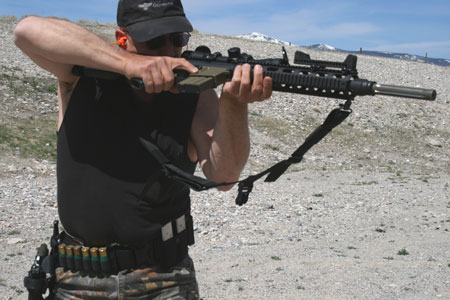
The improvement I like best for the AR-15 is the flat-top upper. It gives you more options for sighting and makes the rifle more scope-friendly. Here's a look at AR-15 optics.
Having numerous options for attaching the front sight to a picatinny rail-type forearms and gas blocks really adds to the gun’s versatility. But with only a few exceptions you can’t have both a scope and iron sights at the same time.
DPMS Panther Arms has added more utility to the flat-top upper, letting the rifle be a close-quarters battle weapon complete with lights or a long-range varmint/sniping gun with some accessories. Don’t get me wrong. I still love a bolt gun, but the AR can easily be changed for various utilities. And the DPMS picatinny-railed upper allows even more options to this already modular weapon. I decided to try one.
You don’t have to use the rails on the railed upper, but they are there if needed. It could offer another way to add peep sights to a scoped rifle. Most scopes have a minimum focusing distance, and a blurry sight picture is unacceptable in combat. A scoped rifle or carbine on a flat-top is difficult to operate in close-quarter situations, and an all-around tactical weapon should be ready for either.
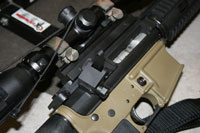
This upper doesn’t have the dust cover and forward assist to which many AR users are accustomed. For those who like to tinker with ARs it’s nothing unusual to experience minor problems with the bolt closing or locking open after changes are made. Usually, if the bolt is not locking back or closing fully, replacing the buffer with a shorter or longer model will solve the problem. I’ve also occasionally experienced closing problems if the bolt isn’t fitted to the barrel. On this gun, I used a bolt and barrel that already fit properly. So just as a reminder, if you’re going to change these parts, you’ll need some slight fitting, or DPMS can sell you fitted parts.
I topped the receiver with a Leupold Mark 4 2.5-8×36 MR/T scope. It has an illuminated mil-dot reticule and is a bit shorter than other models. Shorter scopes work better on AR-15s because of the charging-handle access. A charging-handle extension is a welcome attachment for a scope, as it allows better access. The 2.5X setting gives you a better close-range sight picture, but not quite enough for close-quarters work. The AR I was using had a match stainless barrel from DPMS. One of the company’s lightweight four-rail hand guards let me add a light and front sight. With the heavy match barrel, I wanted the lightest hand guard possible. Some of the railed hand guards are quite a bit heavier than standard guards, but the DPMS guard was light enough to keep the front weight of the rifle manageable.
Options
Streamlight makes various lighting systems for rifle work, and I gave the company’s new Super Tac light a try. It operates on 3-volt batteries and produces 135 lumens for two-and-a-half hours, and then 110 lumens for another hour. That’s plenty of light for a rifle in a combat situation. Streamlight also makes attachments to add this accessory to the hand guard accessory rail, including a vertical grip that holds the light. The grip has a hollow handle with a treaded cap for extra batteries and other necessities.
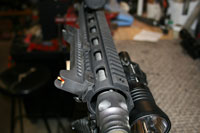
DPMS’ lightweight hand guard can be adjusted on the rifle at an angle coinciding with the rail on the front or back of the upper. That lets you line it up with the flat-top upper rail for sights across the top, or angled so you can twist the rifle and use sights on the side in lieu of a top-mounted scope. You can mount DPMS’s Mangonel flip-up front and rear sights on the rails to facilitate close-quarters aiming. Then, you simply twist the rifle to the left (if you’re right-handed) and aim down the side. I suppose you could use the back rail for sighting if you’re a southpaw. The back rail would also be an excellent spot for a laser sight, especially if you didn’t have a four-rail hand guard.
I liked the two positions of the flip-up Mangonel front sight. The point of impact was a bit low when I test-fired the system, and the lower position brought it up a bit. Further adjustments can be made as usual on an AR sight by adjusting the post. These sights come with a huge lock nut that can be hand tightened in a pinch to install. When not in use, they can be folded out of the way. On a railed upper, these sights provide a longer sighting plane and the peep closer to the eye, allowing better focus.
Brownell’s carries DPMS products, of course, but also has its own rear sight in the catalog. This is a great sight that can be quickly pushed out of the way when not in service. On the back rail of the upper, it has an ample-sized hole that let in plenty of light, even in low light. It also has a large tightening knob that can be installed and removed by hand. It’s well made to withstand hard use.
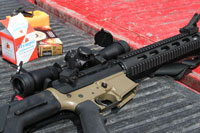
For an alternate iron-sighting system, I like the Short Range Tactical sight from JP Enterprises. Brownell’s also carry this accessory. It attaches to the hand guard rail by the gas block. This sight has an open rear with an AR-type front-post setup. The front post is adjustable like AR sights, and it comes with colored inserts. When switching from the scope to iron sights by twisting the rifle, the sights are out, as if you were sighting down your favorite 1911 or other handgun. When shooting three-gun matches, this is an excellent way to engage those pesky close silhouettes that pop up between longer shots that require a scope. It’s also a nice accessory if you need to suddenly engage a close-range target.
At the Range
I took the rifle to the range, and after a half magazine was quickly placing close shots in a tight group on the hostage target. Both mechanical sighting systems worked without fail, and I could change or remove them without tools. I recommend tightening them with a tool after you have them intact to keep them from loosening up during a competition or gunfight.


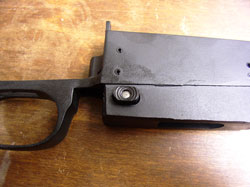
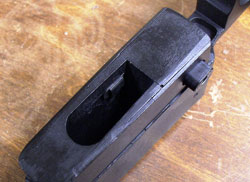
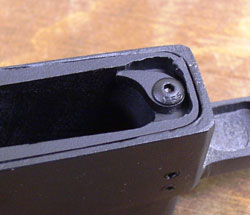
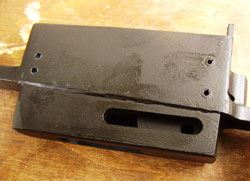
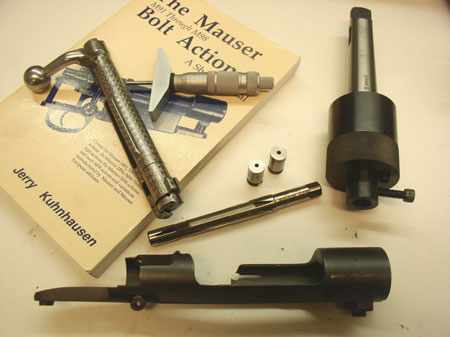

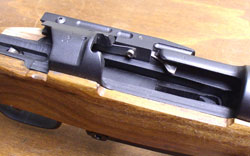

 Collaborative product design and development firm Montie Design announces the availability of its unique portable shooting rest, the second original product conceived, designed, and distributed by the RTP-based company in the last nine months.
Collaborative product design and development firm Montie Design announces the availability of its unique portable shooting rest, the second original product conceived, designed, and distributed by the RTP-based company in the last nine months.
 As the Christian Science Monitor (CSM) reported, “Across America, police departments are using the taxpayer-funded stimulus bill to boost their arsenals with shotguns, handguns, and assault rifles. Take the city of Jeffersonville, Ind. Police there are spending $63,000 of their stimulus bill money to buy 74 new assault rifles for their police cruisers.”
As the Christian Science Monitor (CSM) reported, “Across America, police departments are using the taxpayer-funded stimulus bill to boost their arsenals with shotguns, handguns, and assault rifles. Take the city of Jeffersonville, Ind. Police there are spending $63,000 of their stimulus bill money to buy 74 new assault rifles for their police cruisers.” In the world of hunting cartridges there are some winners and some losers, those cartridges that never quite measured up to the media hype and those that exceeded all expectations. Some of the winners were slow to catch on and some of the losers were slow to die; regardless of false starts, name changes and so forth, Remington had a winner with the .280.
In the world of hunting cartridges there are some winners and some losers, those cartridges that never quite measured up to the media hype and those that exceeded all expectations. Some of the winners were slow to catch on and some of the losers were slow to die; regardless of false starts, name changes and so forth, Remington had a winner with the .280.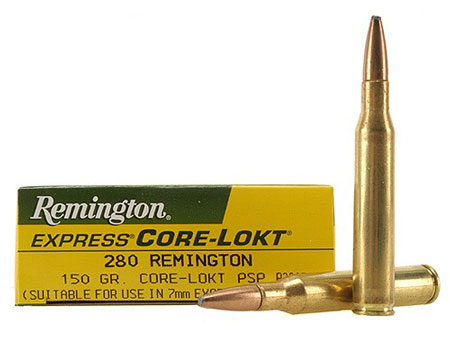
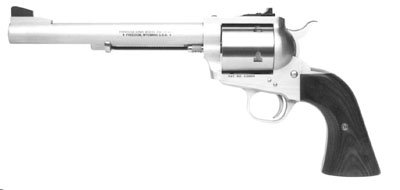
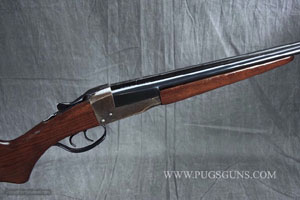 The short answer is yes, but it would take more space than Gun Digest can give us for this Q&A column to give you complete answers. For now I can tell you, sticking to doubles only, that:
The short answer is yes, but it would take more space than Gun Digest can give us for this Q&A column to give you complete answers. For now I can tell you, sticking to doubles only, that: A: Its design features have not been improved from the time it was developed in its most refined form as the G98 rifle and K98k carbine. The rifle and carbine have features that simplify the job of a soldier — mainly to kill the enemy swiftly and efficiently. The magazine is within the stock of the weapon, providing balance and trim lines. The bolt cocks upon opening, making it easier for a soldier to cycle the action.
A: Its design features have not been improved from the time it was developed in its most refined form as the G98 rifle and K98k carbine. The rifle and carbine have features that simplify the job of a soldier — mainly to kill the enemy swiftly and efficiently. The magazine is within the stock of the weapon, providing balance and trim lines. The bolt cocks upon opening, making it easier for a soldier to cycle the action. A: Estimates exceed 102 million. During World War I and World War II, records were destroyed, so we don’t have accurate figures.
A: Estimates exceed 102 million. During World War I and World War II, records were destroyed, so we don’t have accurate figures.

![Best Concealed Carry Guns In 2025 [Field Tested] Wilson Combat EDC X9S 1](https://gundigest.com/wp-content/uploads/Wilson-Combat-EDC-X9S-1-324x160.jpg)


![Best 9mm Carbine: Affordable PCCs [Tested] Ruger Carbine Shooting](https://gundigest.com/wp-content/uploads/Ruger-Carbine-Shooting-100x70.jpg)
![Best AR-15: Top Options Available Today [Field Tested] Harrington and Richardson PSA XM177E2 feature](https://gundigest.com/wp-content/uploads/Harrington-and-Richardson-PSA-XM177E2-feature-100x70.jpg)
